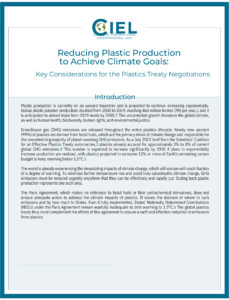
Plastic production is currently on an upward trajectory and is projected to
continue increasing exponentially. Global plastic polymer production doubled from 2000 to 2019, reaching 460 million tonnes (Mt) per year, and it is anticipated to almost triple from 2019 levels by 2050. This uncontrolled growth threatens the global climate, as well as human health, biodiversity, human rights, and environmental justice.
Greenhouse gas (GHG) emissions are released throughout the entire plastics lifecycle. Ninety nine percent (99%) of plastics are derived from fossil fuels, which are the primary driver of climate change and responsible for the overwhelming majority of planet-warming GHG emissions. As a July 2023 brief from the Scientists’ Coalition for an Effective Plastics Treaty summarizes, plastics already account for approximately 3% to 8% of current global GHG emissions. This number is expected to increase significantly by 2050 if plans to exponentially increase production are realized, with plastics projected to consume 13% or more of Earth’s remaining carbon budget to keep warming below 1.5°C.
The world is already experiencing the devastating impacts of climate change, which will worsen with each fraction of a degree of warming. To minimize further temperature rise and avoid truly catastrophic climate change, GHG emissions must be reduced urgently anywhere that they can be effectively and rapidly cut. Scaling back plastic production represents one such area.
The Paris Agreement, which makes no reference to fossil fuels or their petrochemical derivatives, does not ensure adequate action to address the climate impacts of plastics. It leaves the decision of where to curb emissions and by how much to States. Even if fully implemented, States’ Nationally Determined Contributions (NDCs) under the Paris Agreement remain woefully inadequate to limit warming to 1.5°C. The global plastics treaty thus must complement the efforts of this agreement to ensure a swift and effective reduction in emissions from plastics.
To effectively address the climate impacts of plastics, the global plastics treaty needs to incorporate ambitious obligations that specifically target global plastic production. Ninety percent (90%) of GHG emissions associated with plastics stem from the extraction of raw materials, including fossil fuels and bio-based feedstocks, and production processes, which encompass refining, steam cracking and gasification, and polymerization. Reducing emissions from plastics requires a significant reduction in plastic production.
Several Member States of the Intergovernmental Negotiating Committee (INC) to develop an international legally binding instrument on plastic pollution have already identified the need to tackle global plastic production to address the climate crisis.
This brief aims to inform the ongoing plastics treaty negotiations by compiling the current evidence on how prevailing production trends are fundamentally incompatible with achieving planetary climate goals, and provides recommendations on how obligations to address plastic production could be incorporated in the treaty to support their achievement.
Read the report.
Published September 25, 2023.
